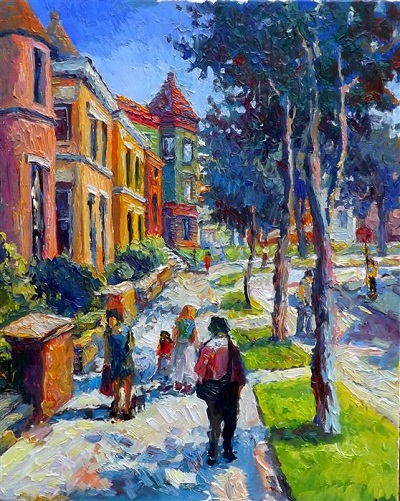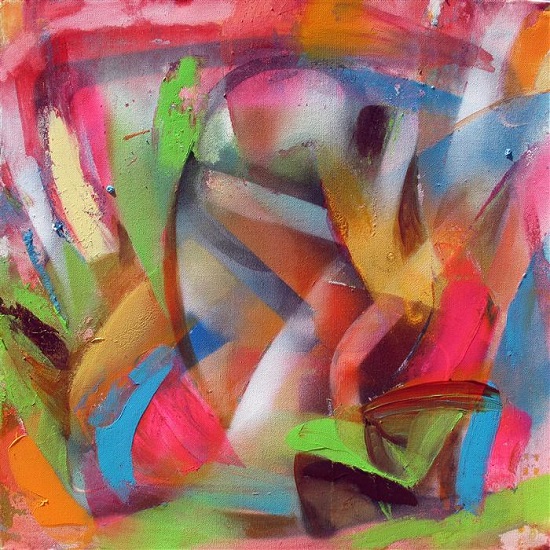A piece of art news I found out today, I thinks it's a good message for artists who selling their art works online.
"In early August, Amazon launched its second entry into the art category with Amazon Art, promising fine art to the masses at reasonable prices. With the new marketplace, you don't need to leave your bedroom to peruse or purchase. In fact, it's downright convenient.
Gloria Blatt's Fioridiprimavera. Still from UGallery.
For collectors -- art demystified
Let's be honest; prior to the digitalization of art buying, art culture was often seen as a private club, only accessible to deep-pocketed collectors with a rarefied pedigree. The traditional brick-and-mortar gallery is actually the physical manifestation of this ethos, as only an exclusive few artists are represented, with their art typically pricing them out of the everyday buyer's budget. This is why you'll often hear those outside of the traditional art community labeling galleries and art houses "intimidating." They seem inaccessible to novices who are genuinely interested in art, yet unsure how to find quality work. The art community has built an elitist reputation that has hurt its ability to organically expand and sell artwork on a larger scale over the long term.
Today, however, online art platforms are disrupting and reversing the old order. Services like Amazon Art, UGallery and others are breaking down the traditional barriers to entry for buyers and demystifying the purchase process. Rather than visiting a physical gallery without insight into pricing or the artists they have on hand, you can visit a curated online gallery and browse thousands of pieces with all the information you need on the artist involved. It's not a nerve-wracking experience by any means. You can take your time to learn, without expectations or pressure. There's transparency enabled through online galleries that make buying a whole lot easier.
Online galleries also represent more artists, meaning larger inventories and a more varied collection, with different price points for any budget, making art more accessible than ever.
For artists -- sell and be seen
Prior to the launch of the online art gallery, to be successful and carve out an actual career, artists needed to develop close relationships with physical, brick-and-mortar galleries and art houses to help market their work, drive sales and establish credibility. This is easier said than done, of course.
Galleries are notoriously sensitive about the artwork they take on and the artists they ultimately represent, with only a small percentage eventually breaking through. For those artists who don't have physical gallery representation or just aren't located in an area with any galleries -- this happens quite a bit -- an online gallery is the perfect partner. And while some online galleries curate their collection like a traditional gallery, from a sheer physical space standpoint, online galleries aren't limited and are inherently designed to take on more inventory. Plus, in a world where over 70 percent prefer buying online, online galleries, unlike their physical counterparts, are masters of digital marketing to drive real sales.
Moving beyond the accessibility factor, online art galleries offer unparalleled, global scale for artists in a way that traditional galleries can't. Now, an artist based in Michigan can sell a piece to a collector in China. In the past, reaching New York and international markets was a struggle for all artists. Thanks to platforms like Amazon Art, artists are selling worldwide, regardless of location.

Suren Nersisyan's Street in Washington DC (Midday). Still from UGallery.
Online art & physical galleries coexisting
Amazon Art is the culmination of the digitization of art commerce. In just a few years, over 300 online art selling/buying platforms have launched, with the category trying to catch up with demand. And the demand is there. Fully, 71 percent of art collectors have now purchased art of some form online. Now, more than ever, art is becoming less physical, evolving into a more accepted digital-first experience.
This shift is largely representative of our culture's habituation to shopping online. According to a recent UPS study, 70 percent of more than 3,000 online shoppers surveyed in February 2013 say they prefer to shop their favorite retailer online. Beyond shopping, look at online dating. 22 percent of heterosexual couples and 61 percent of same-sex couples report having met on the web. Doing things online is the norm.
Buying art -- which some would argue can be as difficult as dating -- has now been added to the list.
But there's more to the picture here. Yes, selling and buying art online has benefited from an online shopping trend that has been ongoing for years (led by none other than Amazon). But, the migration of the art experience online has actually helped address longstanding issues that hindered artists from succeeding and art collectors from buying.
Here are some of the more noticeable advantages we're seeing from the shift toward online art.

This shift is largely representative of our culture's habituation to shopping online. According to a recent UPS study, 70 percent of more than 3,000 online shoppers surveyed in February 2013 say they prefer to shop their favorite retailer online. Beyond shopping, look at online dating. 22 percent of heterosexual couples and 61 percent of same-sex couples report having met on the web. Doing things online is the norm.
Buying art -- which some would argue can be as difficult as dating -- has now been added to the list.
But there's more to the picture here. Yes, selling and buying art online has benefited from an online shopping trend that has been ongoing for years (led by none other than Amazon). But, the migration of the art experience online has actually helped address longstanding issues that hindered artists from succeeding and art collectors from buying.
Here are some of the more noticeable advantages we're seeing from the shift toward online art.

Let's be honest; prior to the digitalization of art buying, art culture was often seen as a private club, only accessible to deep-pocketed collectors with a rarefied pedigree. The traditional brick-and-mortar gallery is actually the physical manifestation of this ethos, as only an exclusive few artists are represented, with their art typically pricing them out of the everyday buyer's budget. This is why you'll often hear those outside of the traditional art community labeling galleries and art houses "intimidating." They seem inaccessible to novices who are genuinely interested in art, yet unsure how to find quality work. The art community has built an elitist reputation that has hurt its ability to organically expand and sell artwork on a larger scale over the long term.
Today, however, online art platforms are disrupting and reversing the old order. Services like Amazon Art, UGallery and others are breaking down the traditional barriers to entry for buyers and demystifying the purchase process. Rather than visiting a physical gallery without insight into pricing or the artists they have on hand, you can visit a curated online gallery and browse thousands of pieces with all the information you need on the artist involved. It's not a nerve-wracking experience by any means. You can take your time to learn, without expectations or pressure. There's transparency enabled through online galleries that make buying a whole lot easier.
Online galleries also represent more artists, meaning larger inventories and a more varied collection, with different price points for any budget, making art more accessible than ever.
For artists -- sell and be seen
Prior to the launch of the online art gallery, to be successful and carve out an actual career, artists needed to develop close relationships with physical, brick-and-mortar galleries and art houses to help market their work, drive sales and establish credibility. This is easier said than done, of course.
Galleries are notoriously sensitive about the artwork they take on and the artists they ultimately represent, with only a small percentage eventually breaking through. For those artists who don't have physical gallery representation or just aren't located in an area with any galleries -- this happens quite a bit -- an online gallery is the perfect partner. And while some online galleries curate their collection like a traditional gallery, from a sheer physical space standpoint, online galleries aren't limited and are inherently designed to take on more inventory. Plus, in a world where over 70 percent prefer buying online, online galleries, unlike their physical counterparts, are masters of digital marketing to drive real sales.
Moving beyond the accessibility factor, online art galleries offer unparalleled, global scale for artists in a way that traditional galleries can't. Now, an artist based in Michigan can sell a piece to a collector in China. In the past, reaching New York and international markets was a struggle for all artists. Thanks to platforms like Amazon Art, artists are selling worldwide, regardless of location.

While I'm clearly a proponent of the digital art experience, both an online presence and an offline one are necessary for the art world to expand its' base successfully. There will always be the affluent art patron who has cultivated valuable relationships with gallery experts and who prefers to see the work in-person before spending thousands or even millions on an original piece.
Online galleries, on the other hand, support the needs of a previously underserved market of artists and a new generation of art buyers. They're opening up a previously closed channel and bringing "art to the people" in a more personal, accessible and convenient way. Market penetration for original artwork is still relatively small; most people start with prints, where they may naturally feel most comfortable. But the opportunity provided through online art to spark real growth for original work has never been greater."
No comments:
Post a Comment